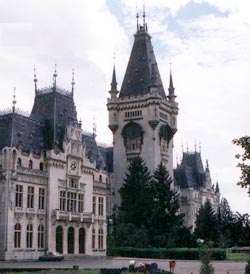Iasi
Iasi The Romanian territory is a classical geographical example of unity in diversity. The Carpathians, the Danube and the Black Sea are the three elements whose mixture leads to the unity and originality of the Romanian territory called the Carpathian-Danubian-Pontic space. If the Carpathians have always been the backbone of the Romanian land and the Danube has connected the Romanians to the sea and the rest of the world, then the Black Sea has always been a crossing place of international traffic offering the Romanians the opportunity to participate in this commercial circuit. Born in the Carpathian-Danubian-Pontic space, the Romanian people, descending from the Dacians and the Romans, represents in the ethno-cultural space of Europe one of the oldest people, having according to the historian Nicolae lorga, "roots which are four times millenial".
|
 |
Forced to suffer the wild attacks of migratory people for a long time, the Romanians constituted themselves into independent states in the 14th century by uniting the existent pre-state territories. Although historic circumstances prevented the forming of a unique Romanian state for a long time there have always existed common origins, traditions and customs, a unitary geographic frame and community of language.
In 1859, as a result of an immense internal effort and a favourable external context, the Union of Moldavia and Wallachia was achieved by the election of Alexandru loan Cuza as Prince of both states. "The Small Union" was consolidated by a reforming work which Europeanized the new state and enabled it to make itself known in external affairs.
The decisive step towards the constituting of the Romanian Unitary National State was taken during the year 1918. By uniting all the Romanian territories some of which had been under foreign rule: Basarabia, Bucovina, Banat and Transilvania, the Great Union was accomplished in Alba lulia on December 1st, 1918.
The anti-communist revolution of December 1989 showed the Romanians' option for democracy and liberty.
Thoroughly European, Romania has given the world cultural patrimony great personalities: the scholar Dimitrie Cantemir, the sculptor Constantin Brancusi, the musician George Enescu, the inventor Henri Coandã, the diplomat Nicolae Titulescu, the historian Nicolae lorga, the dramatist Eugen lonescu, the historian Mircea Eliade, the mathematician Grigore Moisil.
Representing an oasis of Latinity in this part of the world, the Romanians confirm the statement made by the Romanian historian Nicolae lorga: "We have remained Romanians because we could not part from the memory of Rome".
|

